The digital world is always changing.
Before COVID, people used both online and in-person ways to talk to businesses. But during the pandemic, many companies had to go almost fully digital. This changed the way we live and work.
In the same way, ChatGPT is changing how people see and use AI – just like COVID changed the digital world.
Right now, businesses are starting to use AI more than ever, and customer service is one of the areas being affected the most.
In the next part, I’ll talk about how AI is used in customer service, what tools are out there, and what to watch out for before getting started.
What is AI Customer Service?
AI customer service means using smart computer programs, like AI and machine learning, to help customers without needing a real person to step in.
For example, if you bought something online and it didn’t look like what was shown on the website, you would usually talk to the company’s customer support team.
In the past, companies hired teams of people to answer these kinds of questions.
Now, with AI customer service, businesses teach the AI what to say by using their rules and instructions. This way, customers can get help by talking to a machine instead of a person.
This helps companies save money and work faster. AI can answer thousands of questions at once – something human workers can’t do!
Example of Companies Using AI Customer Service
While many companies use AI to help their customers, some use it to fully replace human workers, while others use it just to support them.
Here are some top examples:
Bank of America (Serving 42 Million Customers with AI)
Bank of America helps a huge number of customers every day. People come to them with all kinds of questions – about money, loans, investments, and more.
If only humans did this job, the bank would need two things:
- Workers who understand money and finance.
- A very large team to help millions of customers.
To fix this problem, Bank of America created a smart AI helper called Erica. Erica is a virtual assistant that helps people with their financial needs, just like a real customer service worker would.
Here’s a timeline showing how they’ve continued to make Erica better over time:
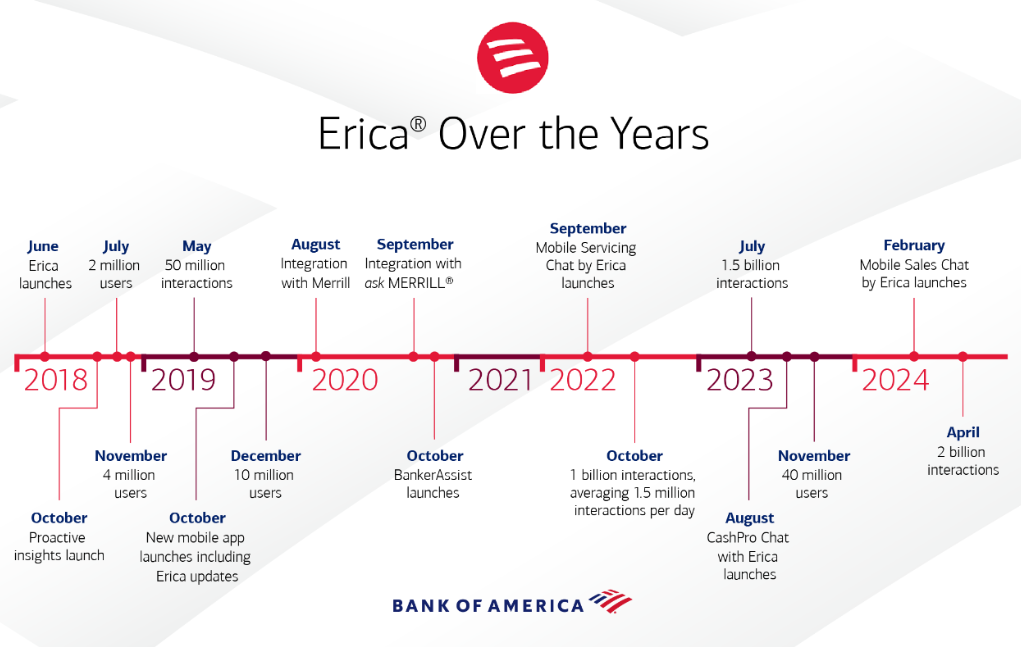
Sephora (Serving 25 Million Members with AI)

Another example of AI customer service is Sephora. Sephora is a beauty brand that knows how important it is to give people a personal experience when they buy beauty products.
In the past, a salesperson in the store would help customers try out different products. But now, Sephora uses special screens in their stores.
These screens let people see how they would look if they used certain makeup products – without actually putting anything on.
This helps Sephora serve more customers without needing a big team of workers. It also gives customers a fun and easy shopping experience, while keeping costs low.
5 Tools to Use for AI Customer Service
The examples I shared above are real, but it’s important to remember that those companies have millions of customers and big budgets.
If you’re running a small or medium business, things might be different. You may have fewer customers and less money to spend.
But don’t worry – there are still smart ways you can use AI to help your business grow without spending a lot.
In the next section, I’ll share some simple and affordable ways you can use AI to support your small business.
1. Zendesk AI (for Enterprise CS Automation)
Zendesk AI is a smart tool that helps big companies provide better customer service. It uses artificial intelligence (AI) to make things faster and easier.
For example, it can figure out what a customer needs, send quick replies, and sort support tickets without needing a person to do it all.
Zendesk AI works well with other Zendesk tools, so it’s great for companies that already use Zendesk.
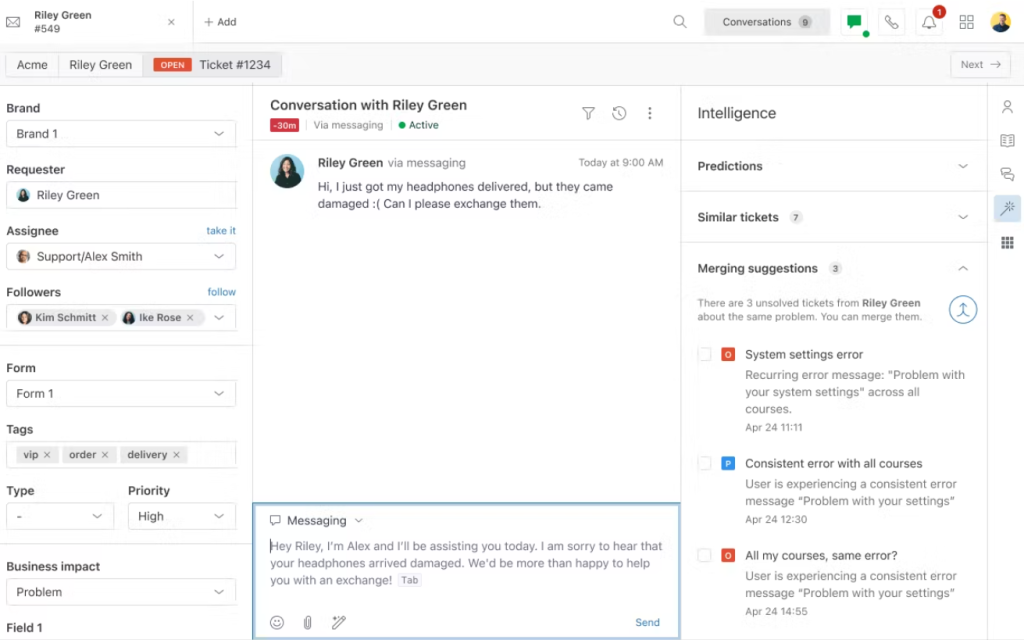
However, some users have noted that while Zendesk AI offers features like intent detection and automated responses, it may require extensive manual setup and might not always understand complex customer questions accurately.
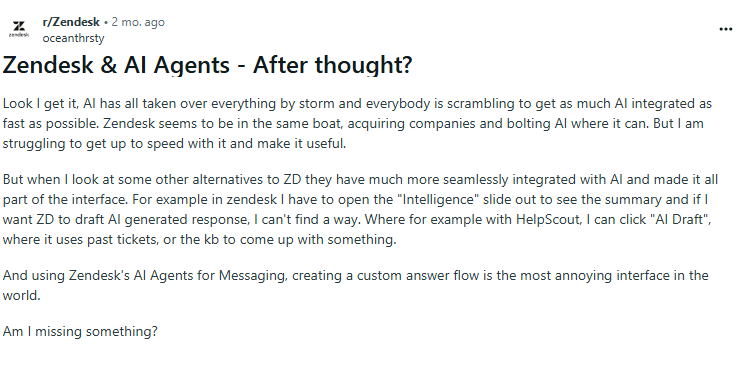
Therefore, while Zendesk AI can be helpful, it’s important for companies to assess if it fits their specific needs.
Here’s a table that covers in detail:
| Feature | Summary | Cost | Best For |
| Automation | Auto-triage, intent recognition, smart replies | $215/user/month (Zendesk Enterprise) | Large teams, high ticket volume |
| Integration | Built into Zendesk, easy setup | Minimal | Current Zendesk users |
| Customer Experience | Faster, accurate replies, 24/7 coverage | AI scaling costs | Customer-first brands |
| Scalability | Handles volume spikes, grows with use | Varies by usage | Seasonal/growth-heavy firms |
| Learning Curve | Simple for Zendesk users | Low | Teams with basic tech skills |
2. Intercom (for Conversation Support)
Intercom is a smart tool that helps businesses talk to their customers. It has live chat, AI support, and messaging all in one place.
Companies use it to answer questions, help people quickly, and stay connected with their customers all day and night. Intercom has a chatbot called “Fin” that can answer common questions so real people don’t have to do everything.

It also has cool tools like a Flow Builder that’s easy to use, custom tags and fields, and helpful AI features like a Knowledge Base and Intents.
You can use Intercom on websites, WhatsApp, Instagram, Facebook, and even through text messages. It also gives businesses strong data and marketing tools to help them grow.
But, it can feel a bit overwhelming when you first start using it, and it might be too expensive for smaller businesses.
| Feature | Description | Cost Estimate | Business Fit |
| AI Support Automation | Fin AI chatbot answers FAQs, routes tickets, learns from past interactions | Starting ~$74/mo + add-ons; AI usage billed separately | Best for small to mid-sized teams needing automation |
| Live Chat & Messaging | Real-time chat on web and mobile, proactive outbound messages | Included in base plans; pricing scales | Ideal for SaaS, eCommerce, subscription services |
| Integration & CRM | Works with CRMs, product tools (Slack, Salesforce, etc.) | Varies with number of integrations | Great for businesses that need customer context |
| Customer Retention | Onboarding flows, targeted messages, and support bot improve retention | Effort investment upfront | Perfect for B2B or product-led growth models |
| Scalability | Easily scales with team size; robust analytics and automation | Costs can grow fast with scale | Good for growing teams with budget flexibility |
3. Tidio (for Small Businesses AI Chat)
Tidio is a tool that helps businesses talk to customers online. It uses live chat and AI chatbots to answer up to 70% of questions without a human. Its smart bot, Lyro, gives helpful, human-like replies and can chat with many people at once.
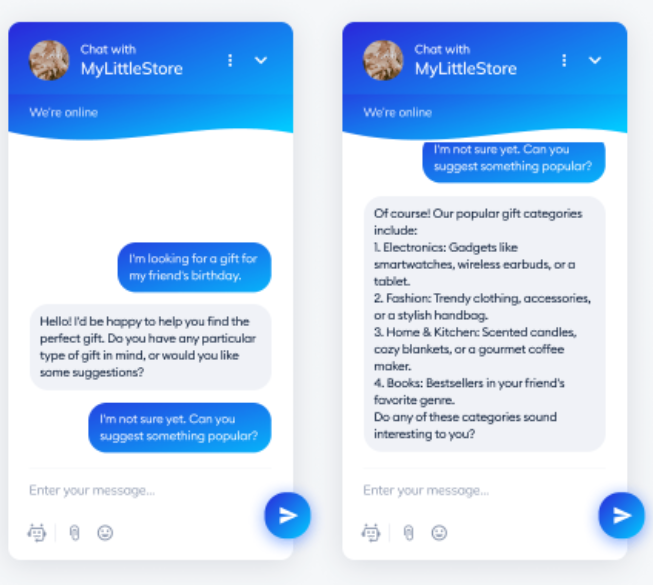
Tidio is easy to use. It has a flow builder for creating chat conversations, lets you add custom tags and fields, and works on websites, Facebook, Instagram, and WhatsApp. It also has built-in live chat and AI features.
But there are some downsides. You can’t do marketing on social apps, can’t use Lyro and flows at the same time, and there’s no way to track how flows are doing.
Still, Tidio is a strong choice for businesses and works with platforms like Shopify, WordPress, and Magento.
| Feature | Description | Cost Estimate | Business Fit |
| AI Chatbot (Lyro) | Handles up to 70% of customer inquiries with human-like responses | Starting at $24.17/month for 100 chats | Great for businesses wanting to automate customer support |
| Live Chat & Multichannel Support | Real-time chat with customers across platforms, including social media | Included in all plans | Ideal for businesses with a strong online presence |
| Integrations | Works with Shopify, WordPress, Magento, and more | Included in relevant plans | Best for e-commerce and content-based websites |
| Customization & Scalability | Custom chat widgets and flexible plans to grow with your business | Plans range from Free to $2,999/month | Good for businesses of any size |
| Analytics & Reporting | Insights into customer chats and chatbot performance | Available in higher-tier plans | Helpful for businesses focused on improving performance |
4. Drift (for B2B Sales)
Drift is a smart tool that helps businesses chat with people who visit their websites.
It uses live chat, chatbots, and messages to help find customers and even book meetings automatically. It also works with tools like Salesforce to keep everything organized.
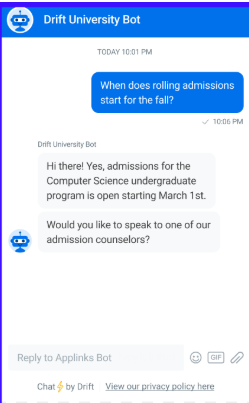
But Drift can get expensive fast. Some of the best features, like powerful chatbots or using it with more than one team, only come with the highest-priced plan.
Also, it doesn’t work with messaging apps like WhatsApp or Facebook Messenger, and people say the app can be a bit slow or buggy. So, while Drift is great for big companies, smaller ones might find better deals somewhere else.
| Feature | What It Does | Cost | Best For |
| Chatbots & Live Chat | Chats with site visitors, books meetings | From $2,500/mo (Premium) | Midsize to large sales/marketing teams |
| CRM Integration | Connects with tools like Salesforce | Included in some plans | Teams using Salesforce or similar CRMs |
| Targeted Messages | Sends messages based on visitor actions | In Premium & up | Businesses wanting personalized outreach |
| Reports & Stats | Shows chat data, lead quality, sales numbers | Higher-tier plans only | Teams improving with data |
| Pricing | Gets pricey fast, esp. for big features/teams | $2,500+/mo, custom for Enterprise | Companies with bigger budgets |
5. Zoho Desk (for AI-assisted Ticketing)
Zoho Desk is a tool that helps businesses take care of their customers by keeping track of questions or problems through email, chat, social media, or phone.
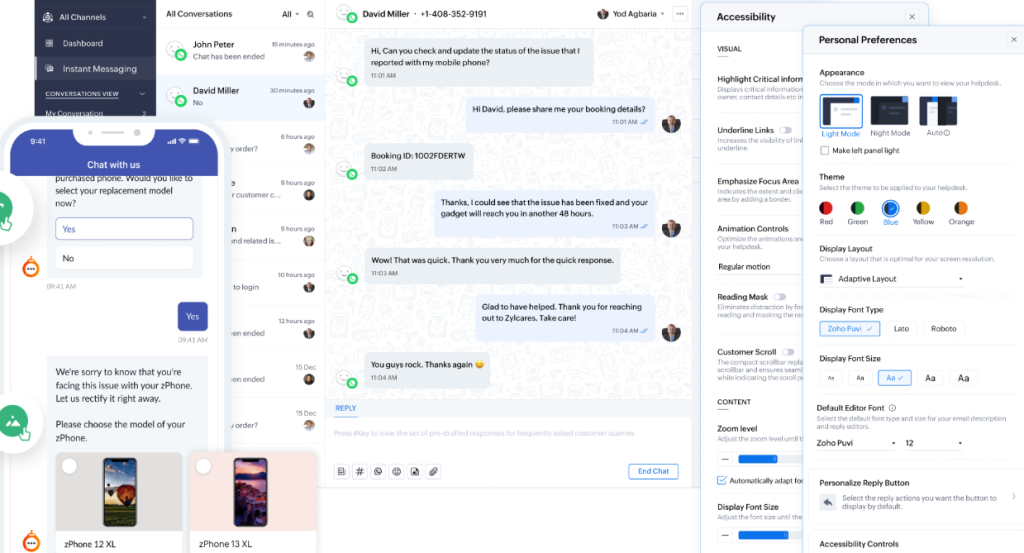
It uses a smart helper called Zia to understand how customers feel and can even reply automatically.
Zoho Desk works well with other Zoho tools, has lots of features, and is a great deal for the price.
But some of the fancy tools cost more, and it can be a little tricky and old-fashioned to use at first.
| Feature | What It Does | Cost | Best For |
| AI (Zia) | Smart replies, detects mood & issues | $40/user/month | AI-focused teams |
| Omnichannel | Handles email, chat, social, phone | $14/user/month | Multi-channel support |
| Customization | Works with Zoho & other apps, customizable | All paid plans | Flexible setups |
| Scalability | Grows with your team | Free–$40/user/month | Small to large businesses |
| Value | Lots of tools for a low price | From $14/user/month | Cost-conscious teams |
Things to Consider Before Implementing AI Customer Service
Using AI chatbots or other software can help a business grow and save money, but it’s important to be careful and think things through before making big changes.
1. Take Baby Steps (Start Small)
Sometimes, AI can have a negative effect on businesses too. For example, if a company has many customers who are used to talking to real people for help, they might not like it if they suddenly have to talk to an AI instead.
If the company changes things too quickly, like switching to AI without warning, customers might stop using the product or feel unhappy with the service.
That’s why it’s important to test changes with a small group of people first, and then slowly make the change for everyone.
2. Test, Monitor & Improve
Once you have added AI to your business, the next step is to set KPIs, which stands for Key Performance Indicators. These are goals or numbers that help you see if the AI is actually helping or not.
For example, you might look at how many customers are happy, how fast problems are solved, or how many people stop using your service.
As you keep using AI, it’s really important to keep an eye on these numbers. If something starts going wrong, like customer satisfaction goes down, you’ll be able to catch it early and fix the problem before it gets worse.
This is why you should always keep checking how things are going and make small improvements along the way.
3. Train your Workforce
When you bring AI into your business, it’s also important to train your workers. That’s because the way things are done will change. Instead of doing all the tasks themselves, many employees will now be watching over the AI and making sure it’s working properly.
This means your team needs to learn new skills, like how to understand what the AI is doing, how to fix problems, and how to step in if something goes wrong.
Training your workforce helps make sure everyone is ready for the changes and knows how to work with the new system.
AI Customer Service VS. Human Agent [Which One is Better]
That’s a big question – which is better: AI or human customer service? The truth is, there’s no simple answer.
At HiredSupport, we started using a lot of AI in our chats. But after some time, we realized it wasn’t always giving people the best experience. So, we switched back to having real people handle the chats.
For small and medium businesses, I really think using humans for chat is the better choice. When your business is still growing, you can’t risk losing even a few customers because of a bad AI experience.
If you want to learn more about the differences between AI and human support, check out our full article on it!
Final Verdict
The main reason people use AI is to save money and make it easier to handle more work as a business grows. But keep in mind, sometimes the experience isn’t always great.
If you have a small business, it might be better to hire another company to help you. For example, you can hire people to do customer service for as low as $7 an hour.
If you want to learn more, you can fill out a form to talk to the sales team, or you can try a free trial too.
![What is Shrinkage in the Call Center [Updated 2025]](https://www.hiredsupport.com/wp-content/uploads/2025/04/What-is-Shrinkage-in-Call-Center-1-300x169.png)

